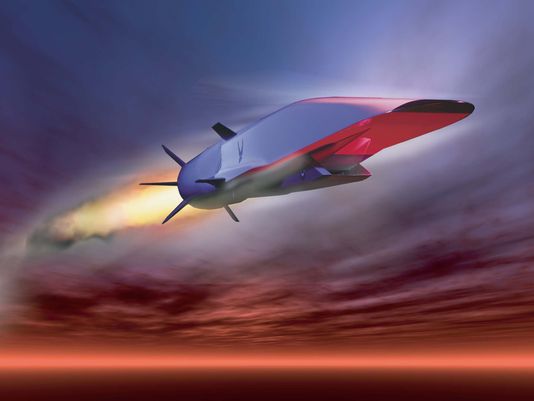Hypersonic flight the next frontier for the Air Force

Almost 70 years after Chuck Yeager and the Bell X-1 team broke the sound barrier, the Air Force is working to defy the next frontier in speed: hypersonic travel.
Korupciya.world reports citing MilitaryTimes
Humans have reached those speeds before. NASA's X-15 program in the 1960's was able to reach speeds of Mach 5. And the Space Shuttle — while reentering the Earth's atmosphere and essentially free-falling from orbit — is estimated to reach speeds of Mach 25.
But the Air Force hopes to make the speed more commonplace than a spaceship landing on the planet. The service is looking to better understand and harness hypersonic flight technology to power missiles and — eventually — aircraft with "supersonic combustion ramjet" engines, or "scramjets."
"I think the biggest things that hypersonic and scramjet engines bring to the Air Force is speed. Speed and responsiveness, that's what we're working to create," said Ryan Helbach, an aerospace engineer with the service's Research Laboratory at Wright-Patterson Air Force Base.
Hypersonic flight is one of the top five "game changing" technologies that could impact the Air Force, as laid out by Maj. Gen. Thomas Masiello, the head of the Research Laboratory.
"What does hypersonic bring?" Maisello said during a presentation in September. "It brings survivability, and it brings the ability to hit time-sensitive targets."
Military leaders have repeatedly pointed to a 1998 incident where President Bill Clinton ordered cruise missile strikes against terrorists in Afghanistan. By the time the warheads finally reached the locations, the prime target — Osama bin Laden — had already left.
Hypersonic technology presents the opportunity to eliminate that lag, shortening the time between when military leaders call for a launch and when a missile lands on target.
Part of the innovation of hypersonic flight is the scramjet engine. Normal rocket engines work by combining a combustible fuel and oxygen. Perhaps the most well-known are the large, orange, liquid oxygen fuel tanks that feed rockets to boost the space shuttle into orbit.
But a scramjet funnels in the oxygen from the outside air, removing the need for the rocket to carry heavy oxygen tanks.
The downside is that the engine doesn't have a means of drawing oxygen in to start the combustion process. Much as sharks need to keep swimming in order to draw oxygen past their gills to survive, so too does the scramjet need to keep moving to keep compressed oxygen flowing into its engine.
The solution so far has been to start off a hypersonic flight with a regular rocket, which can boost the scramjet engine up to the speed needed.
The Air Force's test vehicle, the X-51, built in conjunction with Boeing, was launched via more conventional means from a cradle under the wing of a B-52 bomber. A traditional missile engine was used to get the vehicle traveling fast enough, before the scramjet engine took over to propel the test unit at speeds approaching or surpassing Mach 5.
There were four tests of the X-51 vehicle, one each year between 2010 and 2013. The last launch was the most successful, Helbach said, flying more than 230 nautical miles and solidifying the idea that controllable hypersonic flight is within reach.
"Until you actually fly these vehicles, these engines, you can't truly validate what you're testing on the ground," Helbach said.
For now, the Air Force is focusing on hypersonic missiles, but eventually the military hopes to develop a hypersonic vehicle, similar to the SR-71 Blackbird — one of the fastest planes ever flown that could reach speeds above Mach 3.
"What we're looking for in the longer term is a basically more advanced scramjet powered ISR (Intelligence, Surveillance, and Reconnaissance) vehicle," Helbach said.
Masiello said in September that the U.S. could have "a fully reusable combat ready" hypersonic plane by 2040.
But don't expect the technology to cross over into the travel sector just yet, Helbach warned.
"I would love to see a hypersonic passenger jet," he said. "I think that's many years down the line."
Hypersonic flight involves many hurdles that make it difficult to achieve — especially for something the size of a commercial airliner.
"You have very high temperature, you have very close connections between the weight, the control systems," he said.
Unlike the move from sub-sonic to supersonic speeds, there is no physical "sound barrier" to break when transitioning to hypersonic velocity. But the temperature and pressure keep increasing the faster you go. The X-51 and other hypersonic test vehicles have been outfitted with heat insulation tiles similar to those installed on spacecraft.
It's that heat that has caused previous failures of hypersonic technology. In 2011, the Defense Advanced Research Projects Agency, or DARPA, tested HTV-2, a hypersonic device designed to travel at speeds of Mach 20. But the friction and heat burned through the test vehicle's outer shell, causing it to crash into the Pacific Ocean test range.
DARPA is willing to try again. In April it awarded Raytheon a new contract to develop "tactical boost glide" vehicles. The units are designed to launch from a traditional rocket, detach upon reaching altitude, and then glide to their targets, accelerating to hypersonic velocities before impact.
The defense agency estimates that the first part of the development of the hypersonic vehicles could cost upwards of $60 million.
The development is part of what experts say could become a hypersonic arms race. China has already tested a hypersonic glide vehicle, which the Pentagon has reportedly dubbed "WU-14." Military officials fear that missiles traveling at such high speeds could easily bypass U.S. defenses, demolishing aircraft carriers in the Pacific with conventional payloads or even delivering a nuclear weapon strike on the U.S. mainland.
Политика конфиденциальности | Правила пользования сайтом







